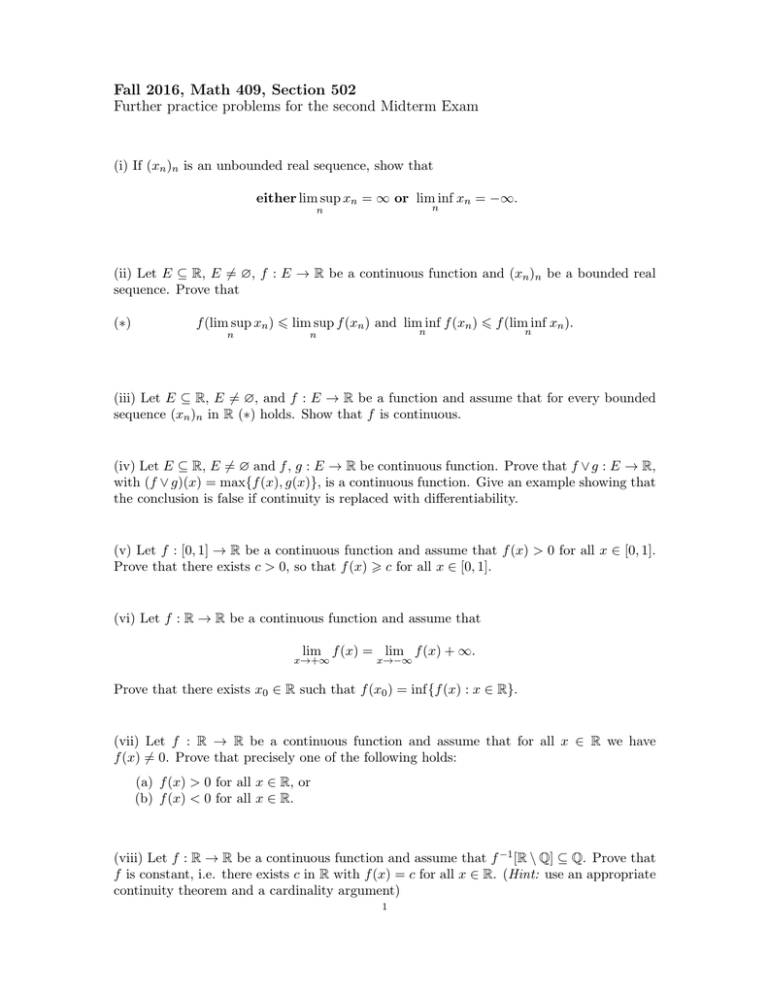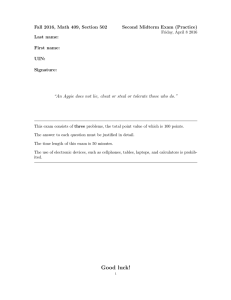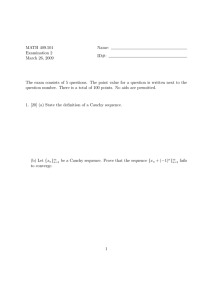Fall 2016, Math 409, Section 502
advertisement

Fall 2016, Math 409, Section 502
Further practice problems for the second Midterm Exam
(i) If (xn )n is an unbounded real sequence, show that
either lim sup xn = ∞ or lim inf xn = −∞.
n
n
(ii) Let E ⊆ R, E 6= ∅, f : E → R be a continuous function and (xn )n be a bounded real
sequence. Prove that
(∗)
f (lim sup xn ) 6 lim sup f (xn ) and lim inf f (xn ) 6 f (lim inf xn ).
n
n
n
n
(iii) Let E ⊆ R, E 6= ∅, and f : E → R be a function and assume that for every bounded
sequence (xn )n in R (∗) holds. Show that f is continuous.
(iv) Let E ⊆ R, E 6= ∅ and f , g : E → R be continuous function. Prove that f ∨ g : E → R,
with (f ∨ g)(x) = max{f (x), g(x)}, is a continuous function. Give an example showing that
the conclusion is false if continuity is replaced with differentiability.
(v) Let f : [0, 1] → R be a continuous function and assume that f (x) > 0 for all x ∈ [0, 1].
Prove that there exists c > 0, so that f (x) > c for all x ∈ [0, 1].
(vi) Let f : R → R be a continuous function and assume that
lim f (x) = lim f (x) + ∞.
x→+∞
x→−∞
Prove that there exists x0 ∈ R such that f (x0 ) = inf{f (x) : x ∈ R}.
(vii) Let f : R → R be a continuous function and assume that for all x ∈ R we have
f (x) 6= 0. Prove that precisely one of the following holds:
(a) f (x) > 0 for all x ∈ R, or
(b) f (x) < 0 for all x ∈ R.
(viii) Let f : R → R be a continuous function and assume that f −1 [R \ Q] ⊆ Q. Prove that
f is constant, i.e. there exists c in R with f (x) = c for all x ∈ R. (Hint: use an appropriate
continuity theorem and a cardinality argument)
1
2
(ix) Let f : [0, 1) → R be a bounded and continuous function that is not uniformly continuous. Show that there exists a Cauchy sequence (xn )n in [0, 1) so that
lim inf f (xn ) < lim sup f (xn ).
n
n
(x) Let f : [0, +∞) → R be a uniformly continuous function. Prove that there exist positive
constants C and M , so that for all x > 0 we have |f (x)| 6 Cx+M . (Hint: use the definition
of uniform continuityPand for each x > 0 appropriately choose 0 = x0 < · · · < xn = x and
write f (x) = f (0) + nk=1 (f (xk ) − f (xk−1 )))
(xi) Let f : [0, +∞) → R be a uniformly continuous function. Prove that
lim (x2 − f (x)) = +∞.
x→+∞
Hint: use (x).
(xii) Let f : R → R be a periodic function with period T ∈ R (i.e. f (x) = f (x + T ) for all
x ∈ R). If f is differentiable, show that f 0 is periodic with period T .
(xiii) Let f : R → R be a differentiable function. If f 0 : R → R is bounded, show that f is
uniformly continuous.
(xiv) Let f : [0, ∞) → R be a continuous function that is differentiable on (0, ∞). Assume
that for all x > 0, |f 0 (x)| 6 1/x2 . ProveP
that f is bounded.
Hint: For each m > 2, f (m) = fP(1) + m
k=2 (f (k) − f (k − 1))). You also need the mean
value theorem and the fact that n 1/n2 < ∞.
(xv) Let f : [a, b] → R be a decreasing function. Prove the following:
(a) For all c ∈ [a, b) we have f (c) 6 lim f (x) = inf{f (x) : c < x 6 b} and
x→c+
(b) For all c ∈ (a, b] we have f (c) > lim f (x) = sup{f (x) : a 6 x < c}.
x→c−
(xvi) Let f : R → R be a differentiable function. Show that f 0 [R], i.e. the image of R under
f 0 , is an interval.
(xvii) Let f : R → R be a differentiable function. If f 0 : R → R is continuous, show that
for every open interval I, there exists an open interval J ⊆ I so that f is either constant or
strictly monotone on J.







